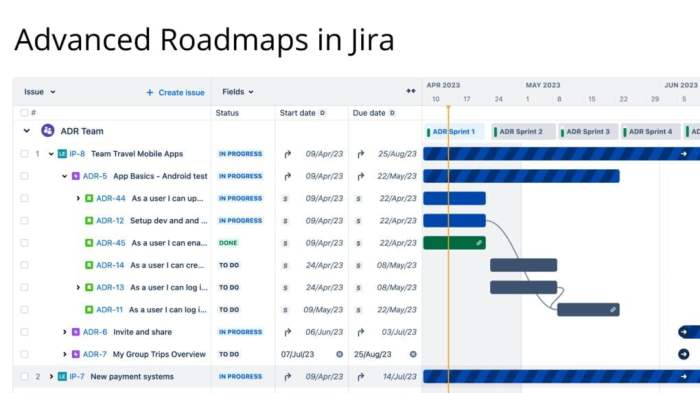Jira Product Roadmap A Comprehensive Guide
Navigating the complexities of product development requires a clear roadmap. This guide delves into the intricacies of Jira product roadmaps, offering a practical framework for defining, planning, and implementing projects effectively. From defining core components to visualizing progress and adapting to change, we explore the entire lifecycle of a successful product roadmap within the Jira platform.
The document Artikels the critical steps for creating, managing, and communicating a Jira product roadmap. It covers essential aspects, including the relationship between Jira issues and the overall product strategy, different planning methodologies, and techniques for tracking progress and gathering feedback. This comprehensive overview will empower product managers to leverage Jira’s capabilities to optimize their development processes.
Defining Jira Product Roadmaps
A Jira product roadmap Artikels the planned features and functionalities for a product over a specific timeframe. It serves as a strategic guide for development teams, providing a shared understanding of the product’s evolution and prioritization of work.
Key Components of a Jira Roadmap
Vision and Goals: The roadmap begins with a clear statement of the product’s overall vision and the goals it aims to achieve. This sets the context for all subsequent decisions.
Features and Epics: The roadmap details the specific features and epics that will be developed. These are broken down into smaller, manageable tasks for execution within sprints.
Timeline and Milestones: A timeline is crucial for tracking progress and demonstrating the expected delivery dates of features and milestones. This allows for realistic planning and stakeholder communication.
Dependencies and Relationships: The roadmap identifies dependencies between features, ensuring that related tasks are completed in the correct order.
Prioritization: The roadmap Artikels the order in which features will be developed, taking into account factors such as user value, technical feasibility, and business priorities.
Types of Jira Roadmaps

Agile Roadmaps: These roadmaps are iterative and adaptable, reflecting the flexibility of Agile methodologies. They typically focus on short-term sprints and frequent adjustments based on feedback and evolving needs.
Waterfall Roadmaps: These roadmaps follow a linear, sequential approach, outlining features and timelines in a predetermined order. They are suitable for projects with well-defined requirements and minimal expected changes.
Jira Issues and the Roadmap
Jira issues are directly linked to the product roadmap. Each issue represents a specific task, feature, or bug related to a particular roadmap item. The roadmap provides context and prioritization for these issues.
Roadmap Structure in Jira
A Jira roadmap can be structured using various boards and workflows. It’s essential to organize the structure in a way that facilitates clear visualization of progress and dependencies.
Planning and Strategy
Developing a Jira product roadmap from scratch involves a series of strategic planning steps. This process focuses on defining the product vision, identifying key features, and outlining the timeline for their implementation.
Roadmap Template
A well-structured template is crucial for a clear and effective Jira roadmap. It should include columns for features, timelines, dependencies, and priorities. Fields should include descriptions, assignees, and status updates.
| Column | Field | Description |
|---|---|---|
| Feature | Name | Descriptive name of the feature |
| Description | Detailed explanation of the feature | |
| Priority | Importance level of the feature | |
| Timeline | Start Date | Planned start date for the feature |
| End Date | Estimated completion date for the feature | |
| Dependencies | Linked Issues | Issues that must be completed before this feature |
User Stories and Epics
User stories and epics are essential components of the roadmap. They describe the desired functionality from a user’s perspective and help break down large features into smaller, more manageable tasks. For example, an epic might be “Improve user onboarding.” User stories under this epic could include “Allow users to customize their profile,” and “Provide clear instructions for setting up the account.”
Prioritization Methods
Prioritizing features and issues is a critical aspect of roadmap planning. Methods include MoSCoW analysis (Must have, Should have, Could have, Won’t have) and value-based prioritization.
Planning Approaches
Different approaches to roadmap planning exist, such as Agile and Waterfall. Each method has its strengths and weaknesses, and the best approach depends on the specific project needs.
Implementation and Tracking
Implementing the Jira roadmap involves linking Jira issues to roadmap items, visualizing progress, and tracking milestones. This process ensures that development teams stay on track and that stakeholders can monitor progress.
Linking Issues to Roadmap
Jira allows for linking issues to specific roadmap items. This creates a direct connection between the high-level roadmap and the individual tasks that contribute to its completion.
Visualizing Progress
Visual tools within Jira, such as Kanban boards, can help visualize the progress of tasks on the roadmap. Charts and graphs provide a clear picture of current status and expected completion dates.
Managing Dependencies
Managing dependencies is crucial for avoiding delays. The roadmap should clearly identify dependencies between different features and tasks to prevent conflicts and ensure proper sequencing.

